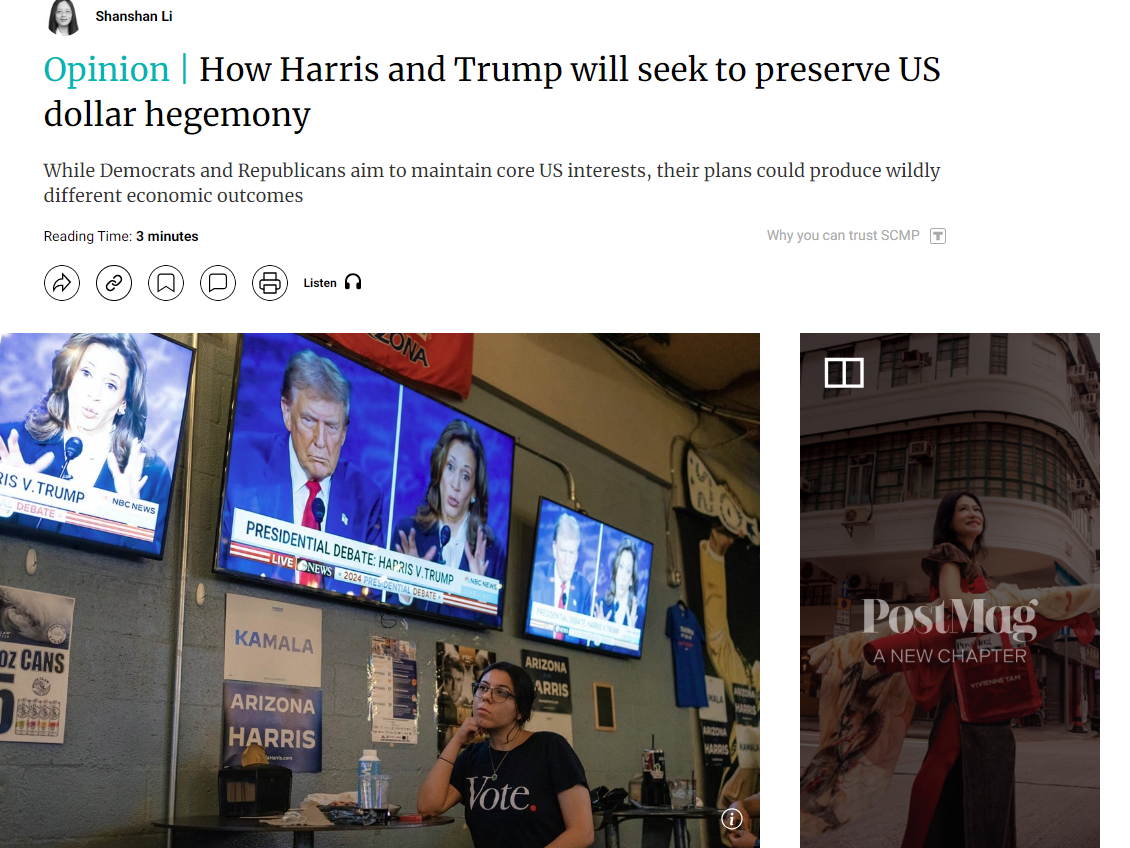LATEST INSIGHTS
Your Present Location: LATEST INSIGHTSLi Shanshan: How Harris and Trump will seek to preserve US dollar hegemony
Source: South China Morning Post Published: 2024-10-20

By Li Shanshan
The “Gilpin dilemma”, an essential concept in international relations theory, stems from the analysis of hegemonic stability theory by American scholar Robert Gilpin. It illustrates the long-term challenges faced by a hegemonic power as it plays a leading role in maintaining international order. The hegemon shoulders the burden of providing global public goods at great cost.
Over time, however, the cost of sustaining the international status quo can exceed the benefits, creating a discrepancy between the hegemon’s power and its commitments. In such a situation, the hegemonic power can face the dilemma of balancing the provision of global public goods and constraints on its resources. The Gilpin dilemma also applies to the shifting influence in the international monetary system.
The 2024 US presidential election is likely to be one of the most fiercely contested in recent American history. This also fundamentally reflects the challenges the country faces in navigating its strategic choices amid the Gilpin dilemma.
While both major political parties aim to preserve US hegemony and safeguard core national interests, their divergent strategies are likely to produce different outcomes. Democratic Party nominee and US Vice-President Kamala Harris is expected to largely continue US President Joe Biden’s multilateral approach, aiming to uphold the existing global order and maintain the role of public goods provider.
In contrast, the unilateralism of former US president Donald Trump – the Republican Party’s nominee – seeks to scale back this role, highlighting a divergence in strategies on how to sustain US hegemony. The provision of global public goods spans political, economic and military dimensions, but at its core lies the calculus of maintaining the dominance of the US dollar and maximising the benefits of the dollar’s status while managing the costs of upholding this position.
From the perspective of foreign and military policy, Biden advocates strengthening international cooperation with allies and reinforcing the US position in global institutions. His aim is to preserve the stability of the global financial system and support the dollar-centric international monetary framework. In contrast, Trump favours reducing US engagement in international organisations and key agreements.
While Biden’s positioning in Russia’s invasion of Ukraine as a defender of international justice and order has provided a boost to the US dollar’s standing, his reliance on sanctions and a perceived double standard over Israel’s conduct in its war in Gaza have somewhat undermined the effectiveness of these efforts.
However, Biden’s diplomatic and military strategy is likely to be more favourable for maintaining the dollar’s global status in the long run, as political and military alliances are indispensable for the formation of today’s US dollar hegemony.
In terms of trade and economic policy, Harris is expected to broadly adhere to the major policy directions of the Biden administration while Trump’s campaign platform includes a pledge to “keep the US dollar as the world’s reserve currency”. Even so, his specific economic policy orientation could inadvertently undermine the dollar’s status.
First, on the fiscal policy front, Biden’s revised fiscal budget proposes an additional reduction of about US$3 trillion in the federal deficit in the next 10 years. In contrast, Trump promises sweeping tax cuts without meaningful reductions to social security spending.
He also proposes a universal 10 per cent tariff on imported goods, a 60 per cent or higher tariff on imports from China and even a “100 per cent tariff” on countries moving away from using the US dollar. While these measures might temporarily boost demand for dollars by driving up inflation, they could also exacerbate the US debt burden and push more countries away from relying on the dollar.
Second, Trump’s stance on immigration is markedly tougher. While immigration policy might not directly affect the dollar’s global standing, it could indirectly undermine its position by affecting the country’s economic growth, technological innovation, international relations and global capital flows.
Third, the Biden administration’s strategy to diversify supply chains, promote climate cooperation and advance technological innovation aims to uphold sustainable global economic development, thereby indirectly supporting the dollar’s international status.
In contrast, Trump’s rejection of climate change, staunch backing of the fossil fuel industry and withdrawal from the Paris climate accord undermine US leadership on these critical issues, indirectly weakening the dollar’s standing on the global stage.
Fourth, on the subject of cryptocurrency, Harris is expected to introduce a regulatory framework for digital assets such as bitcoin. On the other hand, Trump’s looser approach to regulation of cryptocurrencies could accelerate the trend towards decentralisation.
Overall, the Democratic Party’s strategy is more forward-looking in terms of preserving US dollar hegemony and managing the strategy of public goods provision. However, for a hegemonic power facing the prospect of close elections and the Gilpin dilemma, such predictions are fraught with uncertainty, especially considering the dynamic nature of policies and the intricacies of their impact.
For instance, Trump’s tariffs might raise the cost of imported goods, but if the US remains committed to diversifying supply chains across the globe, this could also unlock stronger economic growth and improve the trade balance, thereby being beneficial to the dollar’s power.
Meanwhile, Biden’s meticulous layout of sanctions and strategic moves in Russia’s war in Ukraine requires a high degree of control over the situation. If not handled deftly, it could ultimately have a weakening effect on the dollar’s standing.
Key Words: Li Shanshan, RDCY, US election, US president























































































 京公网安备 11010802037854号
京公网安备 11010802037854号





